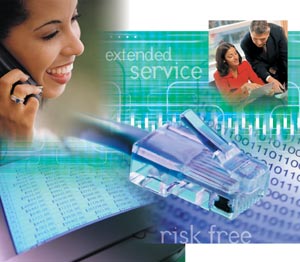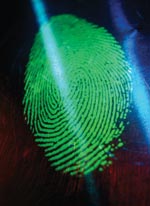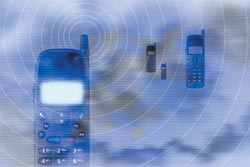|

ITU 020111/EyeWire
|
Security standards
A critical component of our telecommunication and information
systems
The ITU Telecommunication Standardization Sector (ITU–T)
holds regular workshops on subjects of great interest in order to foster the
development of standards that meet market needs. Network security was the topic
of a recent workshop held in Seoul on 13 and 14 May 2002, at the invitation of
the Government of the Republic of Korea. These dates were agreed upon to take
advantage of related events also staged in Seoul in the month of May, namely:
the Security World Expo 2002 Exhibition and the ITU Strategic Planning Workshop
on “Creating Trust in Critical Network Infrastructures”.
Security standards have become a critical component of our
telecommunication and information systems. Recognizing this, the
Telecommunication Standardization Advisory Group (TSAG) requested ITU–T Study
Group 17 in March 2001 to organize a technical workshop on network security.
Study Group 17 is the lead Study Group for communication systems security. TSAG
also requested all ITU–T Study Groups to consider their contribution or
participation in the workshop to allow the Sector to take a more active and
visible role in global standardization in the area of security of networks and
services.
ITU–T Study Group 17: leading the way
Study Group 17 is the Lead Study Group for communication
systems security (LSG CSS). Its activities can be classified into two
categories. The first category comprises core activities centred around defining
and maintaining overall security frameworks. The second encompasses project
management activities involving the coordination, assignment and setting of
priorities for initiatives that would lead to the timely development of
communication system security Recommendations. Herbert Bertine of Lucent
Technologies and Amardeo Sarma of NEC Europe Ltd are the co-Chairmen of Study
Group 17.
LSG CSS works closely with other study groups to identify and
develop security solutions. There are no plans for LSG CSS to have a role in
developing specific cryptographic algorithms, registering these algorithms (ISO
performs the registration function effectively now), or in certifying the
security of specific systems.
Question 10/17 – Security services, mechanisms and protocols
Activities being carried out at present under this Question
relate to communication systems security, security management, mobile security
and telebiometrics.
Hiroyuki Ohno (Japan) is the Rapporteur for Question 10/17
for the period 2001–2004. He is also the coordinator for LSG CSS activities.
The Compendia
Based on information requested and received from all ITU
Study Groups concerning security activities, LSG CSS compiles and produces two
publications, namely:
-
Catalogue of ITU–T Recommendations related to
communication systems security.
-
Compendium of ITU–T approved security definitions. This
is a listing that will continue to be developed with a view to establishing
a common understanding, and use, of security terms within ITU–T (see http://www.itu.int/ITU-T/studygroups/com17/cssecurity.html).
|
In his welcome address, Kim Chang-Kon, Assistant Minister for
Informatization Planning in the Republic of Korea’s Ministry of Information
and Communication declared: “A growing number of computer attacks such as
hacking and viruses are being perpetrated by people who fully take advantage of
the openness and anonymity of the Internet. And the resulting damages are
spreading the world over within a short period of time. In order to tackle such
information infringement incidents, all nations have to cooperate on the
development of technologies.”
Houlin Zhao, Director of the Telecommunication
Standardization Bureau (TSB) had this to say: “With our increasing dependence
on computer networks, the importance of network security cannot be
overemphasized. We are in a crucial phase and are required to review all of our
technical and societal systems from the aspect of security. To join the world
efforts in addressing security, ITU–T is contributing by providing to the
public its technical knowledge and its perception on security.”
The workshop was open to non-ITU Members, and attracted some
143 experts and participants from ITU–T Study Groups and other standards
development organizations (SDO), such as the International Organization for
Standardization/International Electrotechnical Commission (ISO/IEC), 3GPP2,
OASIS, the Internet Engineering Task Force (IETF) and the academic community.
High on the workshop programme were five technical sessions
covering security requirements and telecommunication reliability, hot topics on
IP-based network security, security management, biometric authentication and
mobile security technologies. All presentations are available at http://www.itu.int/ITU-T/worksem/security. That the workshop was very well
attended is in no small part thanks to the efforts of the Vice-Chairman of Study
Group 17, Byoung-Moon Chin from the Republic of Korea, who made an outstanding
effort in organizing local support for the event.
ITU–T Study Group 2
At the end of November 2001, the Telecommunication
Standardization Advisory Group requested that Study Group 2 start work on a
requirements document on telecommunications reliability and security as a basis
for the development of the necessary technical standards in ITU–T. Picking up
this challenge rapidly, the study group appointed Luis Cardoso of CPRM Marconi
(Portugal) as Security Coordinator and commenced work on two new draft
Recommendations:
-
ITU–T Rec. E.sec1: “Telecommunication networks
security requirements” provides an overview and framework that identifies
security threats to telecommunication networks in general (both fixed and
mobile; both voice and data) and gives guidance for planning countermeasures
that can be taken to mitigate risks arising from threats. It proposes a
six-layer security architecture and defines the objectives that each layer
is designed to achieve and maps the security layers to the OSI 7 layer
model.
-
ITU–T Rec. E.sec.2: “Incident Organisation and
Security Incident Handling (Guidelines)”. The purpose of this
Recommendation is to analyse, structure and suggest a method for
establishing an incident management organisation, where the flow and
structure of an incident are focused. The flow and the handling are useful
in determining whether an event is to be classified an event, an incident, a
security incident or a crisis. The flow also covers the critical first
decisions that have to be made.
Full draft texts of these Recommendations are already
available and have been accepted as the basis for further work by Study Group 2.
In addition, a significant amount of work related to telecommunications
security, reliability as well as handling emergency situations takes place in
the Network Management Development Group and the Quality of Service Development
Group. Some of this work may take the form of future Recommendations.
Quality of Service Development Group (QSDG)
The QSDG — a field trial group related to ITU–T Study
Group 2 — recently met in Washington. One of the hot topics of QSDG’s work
is network security. The interworking of GSM mobile signalling on the signalling
links used for fixed networks was discussed. In addition the issue of privacy in
wireless LAN technologies was reviewed.
|
Security requirements and telecommunication reliability
This session focused on security issues and requirements in
four areas:
Chidung Lac of France Telecom R&D focused on network
reliability, highlighting the difference between safety (due to natural
disaster, for example) and security (due to man-made events). Several protection
and restoration mechanisms for network reliability were explored.
|
ITU 970055/INMARSAT


When disaster strikes, efficient communications can
make the difference between life and death…
ITU 020056/EyeWire
|
Greg Shannon, Security Standards Manager at Lucent
Technologies (United States), remarked that “standards development bodies have
a unique ability and responsibility to address security vulnerabilities in
protocols.” He went on to define a security vulnerability as a flaw or
weakness in a system’s design, implementation or operation that can be
exploited to violate that very system’s own security. Mr Shannon’s
presentation further explained that “a security vulnerability is not: a risk,
a threat, or an attack. A security vulnerability combined with a security
threat, creates a security risk. And hence, vulnerability combined with threat
equals risk.” He also noted that while threats change over time, security
vulnerabilities may well last for the lifetime of a protocol.
A number of recommendations were made to standards
development bodies for consideration when developing protocols. These include:
promoting open security discussions, providing protocol security guidelines to
all protocol authors and identifying root causes of vulnerabilities.
Harold Folts, Senior Systems Engineer at National
Communications System or NCS (United States) focused on “Emergency
Telecommunication Service (ETS) Standards Initiatives”. His presentation
highlighted the role of telecommunication services in supporting recovery
operations. It stressed the importance for authorized users, such as medical
services, fire brigades or government and industry recovery teams, to get
priority access to telecommunications from public networks, especially early in
a recovery operation. Serious disasters happen anytime anywhere.
Telecommunication resources are often stretched to the limit, with damaged
infrastructure and very high traffic loads during times of disaster, for
example, earthquakes, hurricanes, floods, fires, volcanic eruptions or terrorist
attacks. Initial recovery response teams need telecommunication support to
organize and coordinate recovery resources immediately. Response teams must
depend on readily available public telecommunication resources — Internet,
cellular or the plain old telephone service (POTS).
|

ITU 010015/Avaya Inc.
|
In-Seop Lee of Korea Telecom underscored two trends that make
network security a matter of increasing importance and vital interest. “Firstly,
the explosive growth in computer systems and their interconnection via networks
has increased the dependence of organizations and individuals alike on the
information stored and communicated using these systems. This, in turn, has led
to a heightened awareness of the need to protect data and resources from
disclosure, guarantee the authenticity of data and messages and protect systems
from network-based attacks,” he said. Secondly, cryptography and network
security have evolved considerably, leading to the development of practical,
readily available applications to enforce network security. He then reviewed the
various security mechanisms to counter threats. Six layers of network security
were noted: security auditing, security tools, software, monitoring, physical
security and network administration. Secure e-commerce was taken as an example
by examining security and trust as part of a risk-management strategy.
Hot topics on IP-based network security
Professor Suguru Yamaguchi of the Nara Institute of Science
and Technology (Japan) provided some statistics on security incidents observed
recently (port scanning and probe, intrusion or break-in and denial of service)
and identified some reasons for attacks (poor design and implementation of the
operating system and of security-conscious protocols and low focus on
eliminating security loopholes). More work is required on network security, and
this should involve industry (technology development and engineering),
telecommunication operators, regulators, policy-makers and the insurance sector.
The importance of disseminating information on security threats was stressed,
and the Computer Security Incident Response Teams (CSIRT) was cited as an
important actor in this context.
Dong-il Seo of ETRI (Republic of Korea) introduced a major
study item related to trace-back technology, which applies to systems locating
hackers. It is generally considered that the automatic trace-back of the hacker
on the Internet is too difficult because of the anonymity of Internet and
possible re-attacking via several hosts. So, to date, the most general type of
trace-back used is done by experts based on a log analysis. He went on to
describe two variants of trace-back systems: IP packet trace-back (used to find
the real location of the hacker who is sending the packet that adapted the
spoofed IP address), and connection chain trace-back (used to find the real
location of the hacker who attacks the victim via several intermediate hosts).
Several trace-back techniques may be used and new systems are under
consideration to develop a quick and accurate real-time trace-back system, which
is needed urgently.
Pierre-André Probst, Chairman of ITU–T Study Group 16
presented the multimedia security studies within this Study Group. Main
achievements and new projects were described. Multimedia security covers the
security needs of multimedia applications such as audio/video conferencing,
Internet protocol-based telephony and collaborative data conferencing. Some of
the nuts and bolts of IP telephony are being hammered out in Study Group 16,
where one of the success stories has been the ITU–T Recommendation H.323 suite
of protocols — recognized as a global standard for IP telephony. Another
recent achievement is Recommendation H.235 Annex F, which describes a security
scheme for Voice-over-IP (VoIP) carriers that deploy public-key based security
infrastructures in electronic commerce-enabled environments.
Here, subscribers and H.323-based network entities alike
authenticate initially with their digital certificate and prove their identity
by applying digital PKI-based signatures. Once authentication has been achieved
and permission granted, subscribers can make secure VoIP calls.
Semyon Mizikovsky of Lucent Technologies (United States)
described one of the current security activities in the Internet Engineering
Task Force targeted to support mobile IP architecture, including combined mutual
authentication and session key generation protocols for Mobile Nodes (MN)
suitable for use at layer-2 in 802.1x networks (such as 802.11 wireless local
area networks — LANs).
Information security management
Professor Jungduk Kim of the Chung-Ang University (Republic
of Korea) shared his views on future standardization topics in the area of
information security management. Since information security has long ceased to
be considered purely as a technical issue, and has instead become more of a
management issue in any organization, there are many aspects to be standardized
in the information security management field. In the presentation, the functions
and processes of information security management were introduced to show the
areas that are covered in the standardization activities including the
International Organization for Standardization and various national bodies.
|

ITU 020131/PhotoDisc
|
Among the many issues not addressed in standardization
efforts, three topics were given priority: information security metrics
management, incident cost analysis and return on security investment. The
rationale to cover these topics in future standardization efforts was also
discussed.
Ted Humphreys of ISO/IEC/JTC 1/SC 27 focused on the
ISO/IEC 17799 International Standard. The standard was introduced as the best
practice for information security management: a risk-based approach for defining
policy and procedures and for selecting appropriate controls to manage risk.
Professor David Chadwick, Information Systems Security,
University of Salford (United Kingdom), made a presentation on
privilege management infrastructure (PMI). The fourth edition of ITU–T
Recommendation X.509, adopted in 2000, is the first to standardize the
components of privilege management infrastructures. This complements X.509’s
position as the foremost standard for public key infrastructures (PKI). PMIs
provide a distributed highly secure way of managing authorization tokens (called
attribute certificates), in the same way that PKIs provide an infrastructure for
managing public key certificate authentication tokens. The presentation
introduced delegates to the components and concepts of PMIs as described in
X.509 (2000).
|

ITU 020112/PhotoDisc
|
Biometric authentication
Professor Naohisa Komatsu of Waseda University (Japan)
discussed trends of biometrics standardization, especially in the United States
and Japan. Phil Griffin of the OASIS Security Technical Committee (United
States) spoke on biometric information management for security. Both speakers
referred to the relationship between privacy and biometrics, a very hot topic
not only for biometric authentication but also for the whole information
security area.
Professor Tsutomu Matsumoto of Yokohama National University
(Japan) pointed out the vulnerability of finger printing authentication
technology. Although impressive, biometric authentication is not perfect because
of certain vulnerabilities that exist in almost every system. More secure
systems can be developed by combining biometric authentication with other
authentication mechanisms. There are more than six billion people in the world
today. As Paul Gérôme, an expert in Security Models in Study Group 17 put it,
“the aim is to have over six billion safe and secure biometrically
authenticated natural systems interconnected by secured open networks and
terminals”.
Generally, biometric authentication systems have a
user-friendly interface in the sense that the end-user does not have to remember
special keywords, difficult theories or methods.
|

ITU 020113/EyeWire
|
Mobile security
Krishna Kumar Sirohi, Vice-Chairman of the ITU–T Special
Study Group (SSG) on IMT-2000 and beyond, gave a brief description of SSG
activities. His presentation included details on security aspects for mobile
networks with respect to the scope of Question 3/SSG, which covers the
identification of existing and evolving IMT-2000 systems. Security requirements
and the visualized architecture for IMT-2000 and systems beyond, with regard to
core networks were also discussed.
Frank Quick, Chairman of 3GPP2 TSG-S WG4 (Security),
introduced the cdma2000 specifications developed by 3GPP2 which support a
variety of wireless services using both voice and data. The security features of
the cdma2000 system protect service providers against fraud and protect the
privacy of system users. Current cdma2000 security features and future
enhancements were discussed, including the system architecture and the
regulatory environment in which these features operate.
|

ITU 010521/Alcatel
|
DaeHun Nyang of the Information Security Technology Division
at ETRI (Republic of Korea) presented ETRI’s design experience in WAP Identity
Module (WIM), expected to be a very versatile device for secure M-commerce. WIM
cooperates with wireless transport layer security (WTLS) to authenticate
participating parties and to provide confidentiality of network traffic. To
achieve this purpose, various standards including wireless public key
infrastructure (WPKI), X.509, ISO 7816 and PKCS#15 are supported in the WIM
card.
ETRI WIM implementation is designed with a strict layering
approach, which separates the transport layer protocol and the application
protocol from the overall structure. This layered approach helps developers
upgrade easily the internal software modules.
The presentation also showed how the mobile terminal
interacts with the WIM card at the device driver level. Although smart cards
with public-key cryptography do not yet have many applications in the Republic
of Korea, their use is growing gradually with the increase of M-commerce.
|